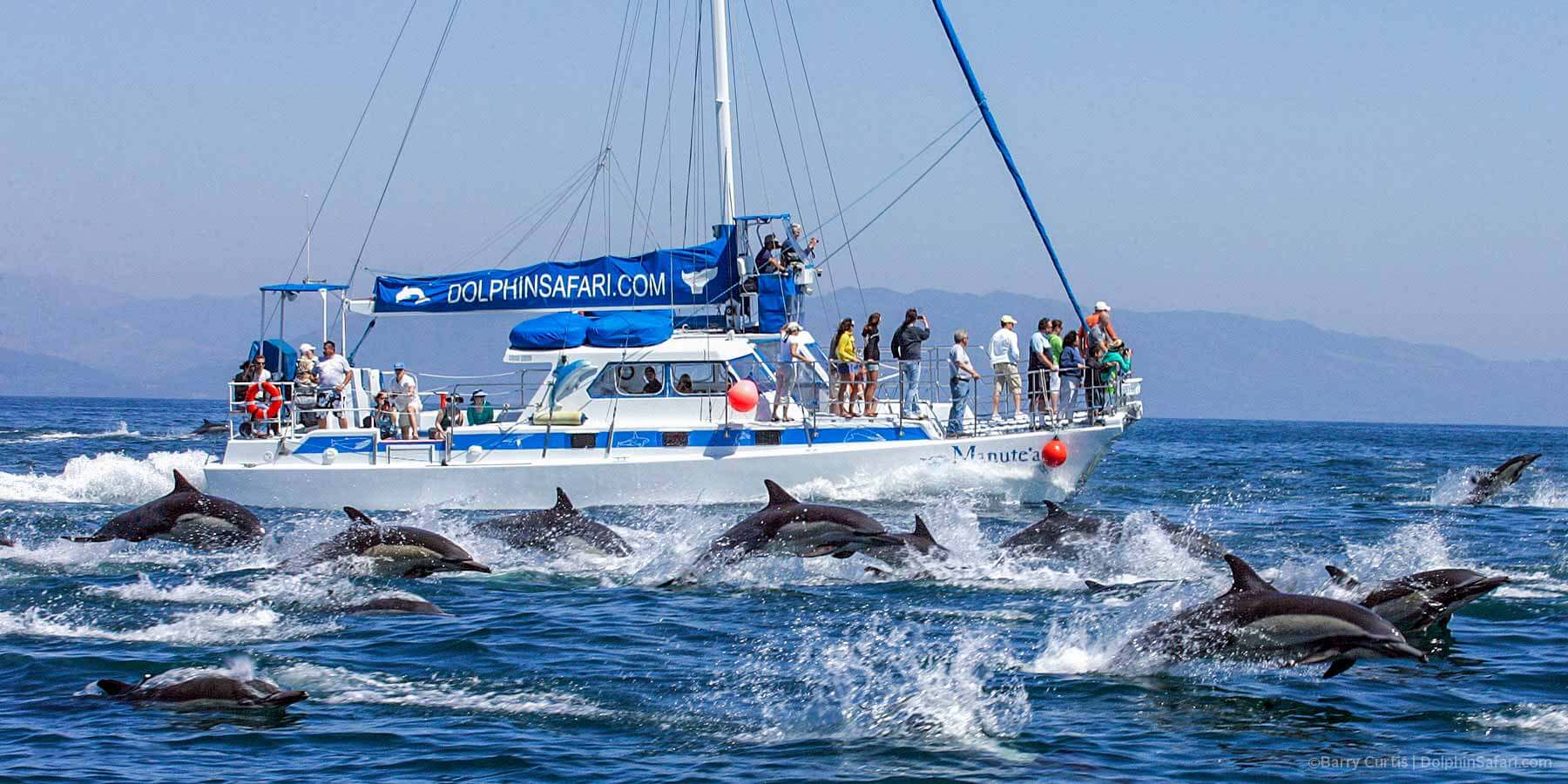Common Dolphin Fast Facts
Scientific name: Delphinus capensis (Long-beaked), Delphinus delphis (Short-beaked)
Class: Mammalia
Average length: 6 to 8.5 feet depending on the species
Average weight: 160 to 500 pounds
Current population: Well over 1 million off the U.S. West Coast
Gestation period: 10 to 11 months
Favorite snack: Anchovy pizza
Best time to see common dolphins and dolphin stampedes in Southern California: January through December
Common Dolphins: Dive Deeper
On our planet today, the ocean covers nearly 71 percent of its surface. In these vast and incredible bodies of water, a large variety of marine wildlife resides therein. The species that roam our favorite saltwater playground can range from tropical fish, whisker wearing sea lions, extraordinary whales, and spotted eagle rays to seals, sharks, and sea turtles, but one species of wildlife is a prominent player in our planet’s underwater world of sea creatures. This acclaimed animal is one of our most favorite cetaceans, the common dolphin.
Although we’ve yet to discover anything remotely common regarding these magnificent mammals, their name is used to identify two similar, yet separate species, both the short-beaked and long-beaked common dolphins. Both species belong to the Delphinidae family, which includes up to 31 different species of cetaceans such as whales, porpoises and other dolphins including the famous killer whale. Members of this menage of marine mammals are well known amongst us land-living folk, and fortunately, the common dolphin is one of the most abundant and familiar comrades of this clan.
Found in almost all of the earth’s temperate waters, both species are highly energetic, social, and playful. They are also highly intelligent animals, shown to be quick learners and showing signs of problem-solving, innovation, empathy, self-awareness, and joy. Similar in demeanor, personality, and preference of family tree members at their annual barbeques, these two species may have a few things in common, including their names, but they do vary from one another.
What do Common Dolphins Look Like?
The short-beaked common dolphin and long-beaked common dolphin differ in size and appearance from another. Short-beaked common dolphins are smaller than their long-beaked compadres, measuring in at six feet long and weighing close to 170 pounds with the males being a wee bit larger than their female counterparts.
This is relatively small when compared to the long-beaked common dolphin who reach lengths of 6 to 8.5 feet long and can mark the scale at 160 to 500 pounds, depending on gender. Short-beaked common dolphins also sport-up a mouth full of 40 to 57 pairs of small sharp teeth in each yapper, whereas the long-beaked common dolphins show off a grill full of 47 to 58 pearly whites.
Although a bit different when it comes to jean size and the amount of time it takes them to floss each night, these two species of dolphins are somewhat similar in certain areas of appearance. Both species of common dolphins have a rounded forehead, often referred to as a “melon”, with a fairly long beaklike rostrum. Their bodies are smooth and sleek, glammed up with a tall, triangular dorsal fin that rests atop their polished back.
Each species has a unique hourglass pattern of pigmentation that stretches across their body. Both can resemble your favorite superhero with a dark gray cape of coloration that runs along the back from the noggin to right below the dorsal fin, exemplifying a “V” shape on each side of its body, thus giving them that unique hourglass shape.
The short-beaked common dolphin wears a tan-like yellow shade of color behind its head on both its right and left side, with a light grey area on both sides below the yellow coloring. For an extra added dose of pizazz, a dark narrow stripe runs from the lower jaw to the flipper, meeting up with their dark colored rostrum. This style of dolphin attire is similar to the long-beaked common dolphin, but the dark colored cape that covers their backside includes the eye area of the long-beaked, whereas it does not for a short-beaked common dolphin.
Like most things, age brings out the glamor, which may be the reason as to why the adults have more prominent coloring whereas the youngsters have a more indistinct, often pale getup.
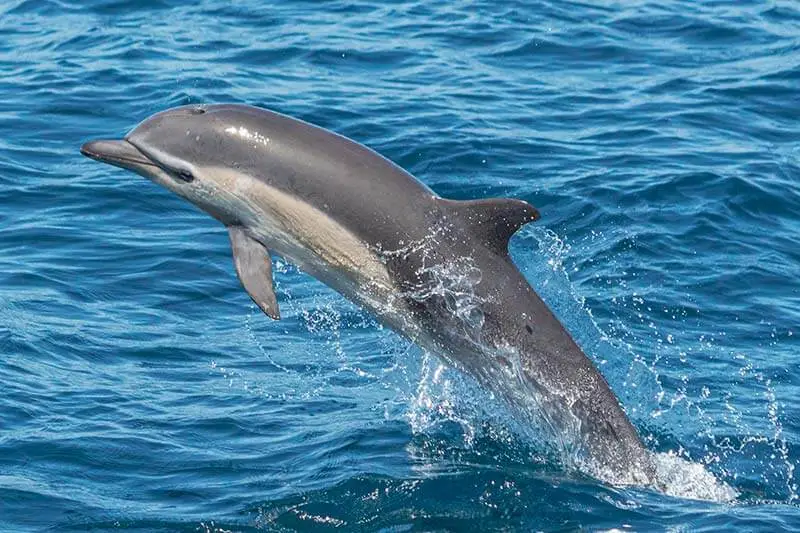
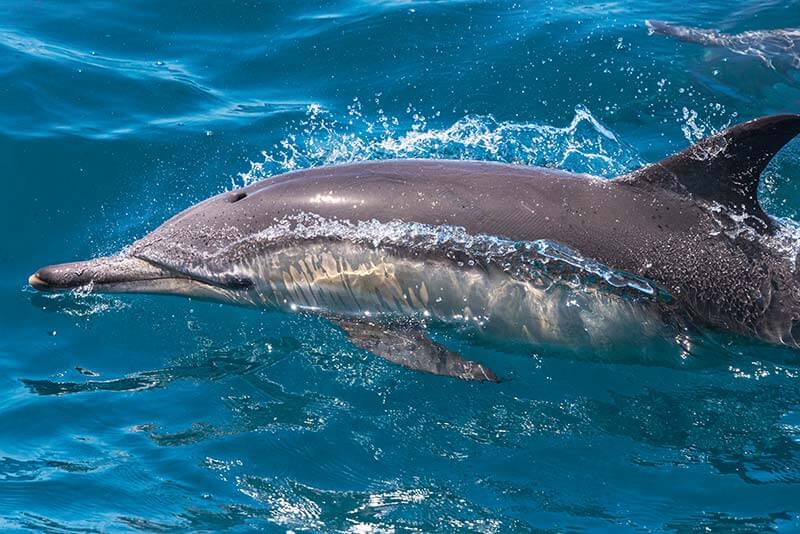
Common Dolphin Mating and Calves
The youngsters in these clans of common dolphins are an amazing sight to see, measuring in at a birth length of 2.5 to 3 feet long as a short-beaked common dolphin and 3 feet long as a long-beaked common dolphin. The mothers of short-beaked common dolphins, who become sexually mature between ages 5 to 12 years, carry their single calf for a 10 to 11 month gestation period and then begin to wean after one year. The short-beaked common dolphin can give birth to a single calf every 2 to 3 years. The long-beaked common dolphin mothers become sexually mature at age 10, carry their calf for a 10 to 11 month gestation period, and can give birth to a single calf every 2 to 3 years.
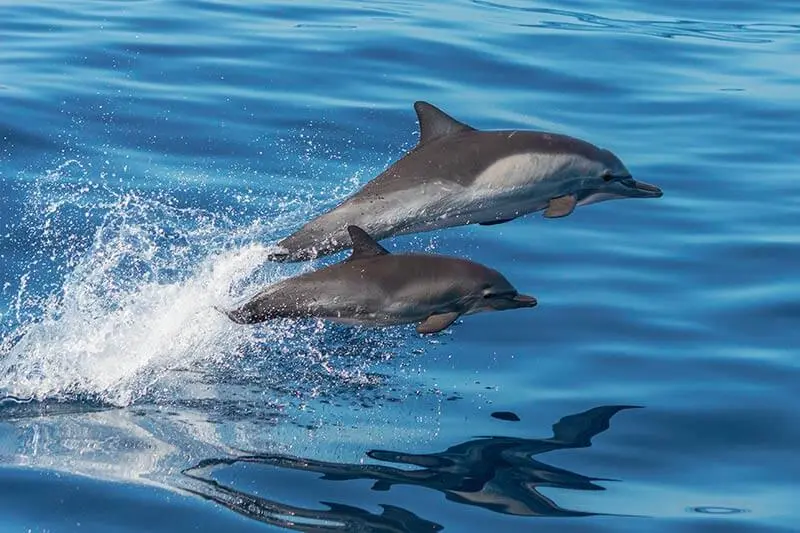
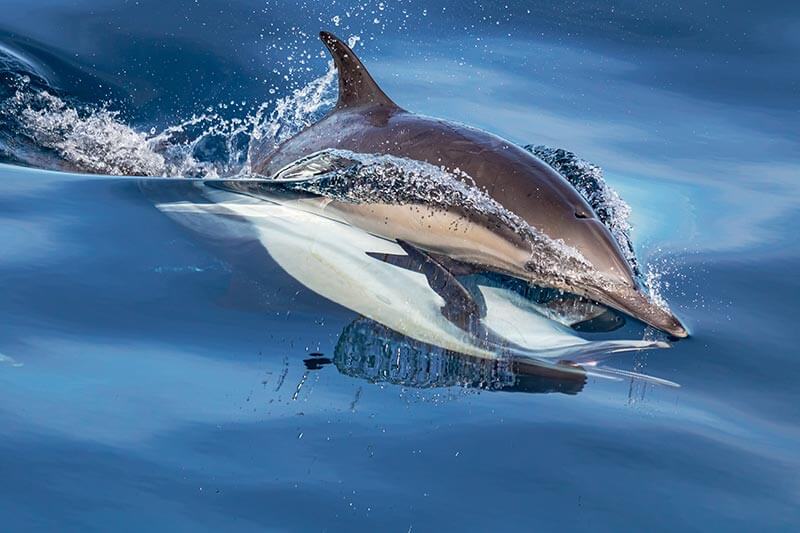
What are Common Dolphin Lives Like?
These common kiddos, along with their Ma and Pa squad, are an abundant species in our deep sea world. Both species belong to groups called pods which can range anywhere from 100 to thousands of members. These groups have been estimated by scientists to reach up to 10,000 dolphins per pod, giving them their famous title of “Mega-pods.”
These sea squads of swimmers are believed to consist of smaller groups of individuals, made up of 20 to 30 dolphins that may be close family members or set apart by age and or gender. Roaming our oceans at speeds of over 30 miles per hour, these pods of dolphins catch and consume small schooling fish such as sardines, mackerel, and anchovies, as well as that tasty calamari often referred to as squid.
The waters along the coast of Southern California are a rich habitat for these intelligent species of wildlife, especially the Dana Point area as it plays host to an abundant amount of fish which these dolphins love to eat. They can consume up to 4 to 6 percent of their body weight per day!
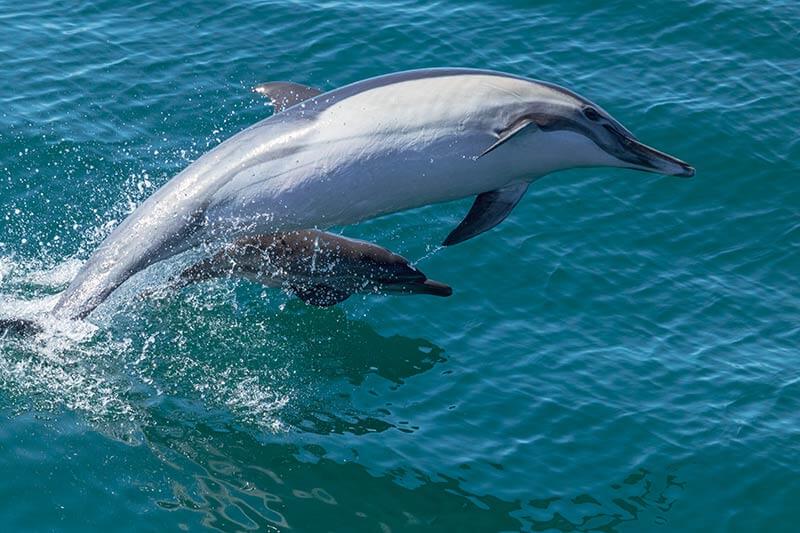
With such a plentiful supply of sustenance in SoCal, it is no wonder why the Dana Point area has more herds of dolphins per square mile than anywhere else in the world. In fact, there are more dolphins in southern California than in Alaska, Hawaii and Florida Combined! Nearly half a million dolphins reside here, with 450,000 of these cetaceans calling the ocean off of Orange County, “home.”
With so many dolphins in our local waters, one may wonder how to spot such incredible numbers. With pods that range from 100 to up to 10,000 in number, it can be an extraordinary experience to encounter such playful and energetic specimens. The dolphin loving crew at Captain Dave’s Dolphin and Whale Watching Safari located in Dana Point, California, provide a unique and up-close experience aboard several seaworthy vessels that are designed to enable passengers to get up close and personal with this amazing wildlife.
As a special treat aboard these daily year-round safari’s, these common dolphins often cozy up next to our boats to “bow ride.” Without warning, a pod may begin “stampeding,” a form of high-speed travel where the dolphins porpoise out of the water at the same time while swimming in one direction.
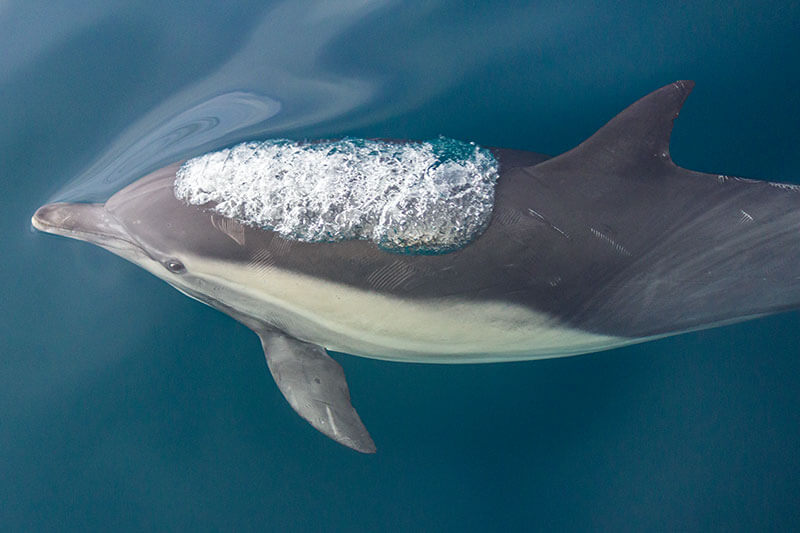
The Dolphin Stampede
This dolphin stampede is nothing less than breathtaking. With hundreds, sometimes even thousands of these incredible mammals leaping in and out of the water as they stampede forward in one direction as if running from or to something at an astounding speed. This unusual yet exciting behavior leaves us both astounded and baffled, as we are uncertain as to why these animals may so randomly do this, but it is no doubt a once in a lifetime opportunity to encounter such an escapade.
For those who have had the amazing opportunity to see this take place, it can seem absolutely surreal. Being aboard a high-tech sailing catamaran out at sea under the warm SoCal sun while cruising along the Southern California coastline is an adventure in and of itself. But adding in a view of a slew of the local wildlife at your fingertips can leave one feeling euphoric.
Imagine it. You and your loved ones are comfortably situated on an eco-friendly vessel, making your way out onto the open ocean to spot your friendly dolphins and large whales. The Captain chimes in with the stellar news that you’re coming up on a large pod of wild dolphins. You make your way over to your favorite viewing spot on the boat, seeing that others are doing the same. Some are reaching over the edge of the boat, cameras in hand as they prepare to capture that Instagram worthy shot.
You notice the eye-spy dolphin and whale tram nets covered with passengers who are sporting up their favorite flying superman self, belly down, as they reach between the netting to say hello to the wildlife below. Your heart starts to speed up as you hear splashes from all around the boat. The ooh’s and aah’s abound, and you’re caught in the middle of a pod of dolphins jumping, diving, and swimming all around you. Some members of your party have made their way up and down into the underwater viewing pods, giving them a unique view of the playful dolphins below as they catch glimpses of their curious stares and chatter of their clicks and whistles.
As you enjoy the magical moments spent with this numerous host of common dolphins, out of nowhere, they begin stampeding in one similar direction all simultaneously as if an invisible green light tells them it’s time to go, and it’s time to go fast! Like a herd of wild horses, they stampede forward, porpoising out of the water in one similar direction. The vessel you are aboard accelerates and you’ve caught yourself feeling like a giddy child with the look of thrill across your face.
There’s truly nothing like it.
Scientists are not exactly sure what causes dolphins to stampede. It’s thought dolphins could be racing to catch up with a tasty treat of fish, or maybe they’re evading a natural predator like killer whales, or perhaps they got word of another pod of dolphins nearby. Did someone say party?
We do know that porpoising is the fastest mode of travel for dolphins because there is less resistance in the air than in water. And we know that dolphins are not fleeing the boat; they love to hang out, bow ride and interact with whale watchers. Dolphin stampedes can happen anytime and without warning off the coast of Dana Point.
Southern California has the greatest density of dolphins per square mile of anywhere on earth. This includes nearly 450,000 common dolphins, as well as several other species of dolphins. Dana Point made famous the dolphin stampede and is one of the best places in the world to see dolphin mega-pods that can number in herds of up to 10,000 animals. Dana Point is the dolphin and whale watching capital of the world®.
With all the excitement that these dolphins and their playful antics provide, there is one concern we at Captain Dave’s share for these beautiful creatures. This is the devastating amount of wildlife that is caught in fishing gear. With nearly 1,000 dolphins and whales dying due to entanglement in fishing gear each day, reaching upwards of 308,000 deaths per year, the catastrophic effects of this entanglement leave us heartbroken and eager for change. Our love for these animals and our zeal for a better way has led our very own Captain Dave Anderson to start and organize Orange County’s first and only dolphin and whale disentanglement group in 2008. Captain Dave is often called upon as a guest speaker and has been featured on The Ellen Show, CBS Morning News, and local network affiliates for his conservation efforts and his success in disentangling wildlife. Recognized worldwide for his conservation efforts has also fueled his passion behind providing sustainable wildlife viewing.
This is why each and every safari we provide is truly eco-friendly. We believe in being good stewards of the ocean, and do our best to enable our passengers to view our earth’s incredible wildlife on safe, eco-friendly, and comfortable vessels.
As a sea mate aboard Captain Dave’s Dana Point whale watching trips, you can have the opportunity to be aboard one of our many eco-friendly vessels while greeting our favorite friends out at sea. These large herds of short-beaked and long-beaked common dolphins are an incredible sight to see. As a special treat, they are a friendly, energetic, and eager bunch awaiting your visit on the open ocean to say hello and take a peek at their zippy selves.
These dolphins can be seen all year round in Dana Point, and with safari’s that depart daily, your unforgettable once in a lifetime opportunity is just a boat ride away.
See you soon!

